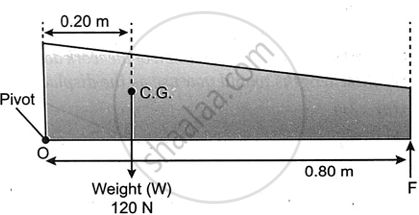Advertisements
Advertisements
Question
Give an experiment to verify the principle of moments.
Solution
Verification of Principle of Moments:
Suspend a metre scale horizontally its midpoint O’, by means of a thread with its other end connected to a fixed support.
Now suspend some weights on both sides of the mid-point and adjust their distances in such a way that scale again becomes horizontal.

Let W1, W2, and W3, W4 be the weights suspended and l1, l2, and l3, l4 are respective lengths.
The weights W1 and W2 tend to turn the scale clockwise while the weights W3 and W4 tend to turn the scale anti-clockwise.
Total clockwise moments = W1 × l1 + W2 × l2
Total anti-clockwise moments = W3 × l3 + W4 × l4
In equilibrium, when the scale is horizontal, it is found that:
Total clockwise moments = Total anti-clockwise moments
W1l1 + W2l2 = W3l3 + W4l4
This verifies the principle of moments.
APPEARS IN
RELATED QUESTIONS
In a beam balance, when the beam is balanced in a horizontal position, it is in ______ equilibrium.
State two conditions for a body acted upon by several forces to be in equilibrium.
State the principle of moments. A meter scale is pivoted at 30 cm mark and it is in equilibrium when a mass of 40 g is suspended from 10 cm mark. Calculate the mass of the ruler.
State the principle of moments.
State two conditions when the work done by a force acting on a body is zero.
One end of a spring is kept fixed while the other end is stretched by a force as shown in the diagram.

(i) Copy the diagram and mark on it the direction of the restoring force.
(ii) Name one instrument which works on the above principle.
A ball is placed on a compressed spring. When the spring is released, the ball is observed to fly away.
(i) What form of energy does the compressed spring possess?
(ii) Why does the ball fly away?
Mention any two conditions for the stability of a body?
A non uniform beam of weight 120 N pivoted at one end is shown in the diagram below. Calculate the value of F to keep the beam in equilibrium.

Give one example of dynamic equilibrium.
